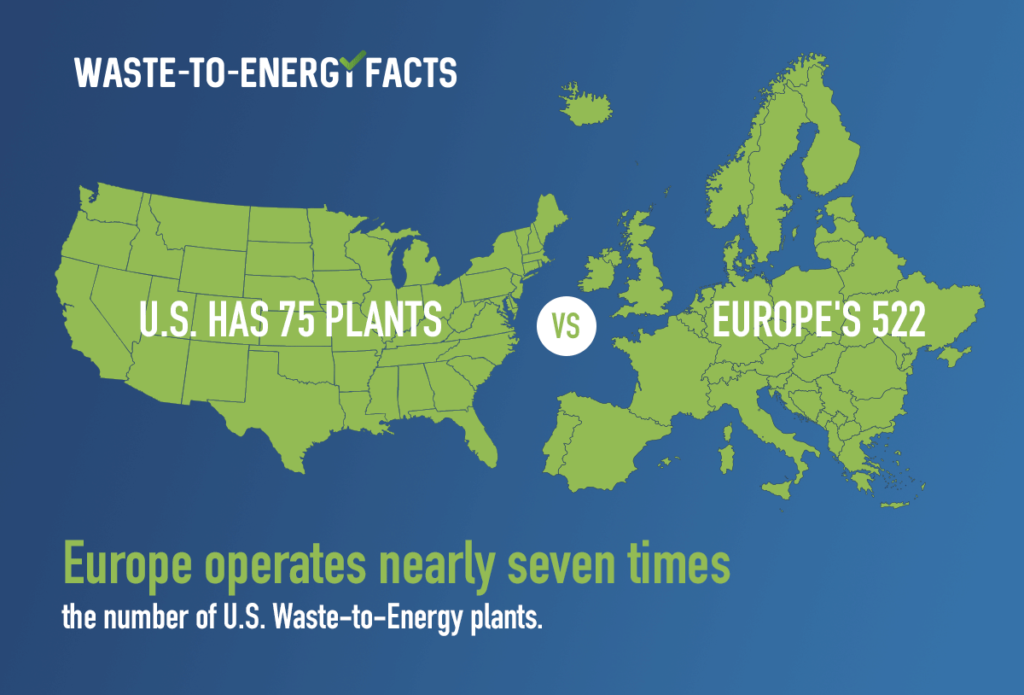Why Waste-to-Energy Works
| 1. | A Climate Solution |
| 2. | Globally Proven Technology |
| 3. | More Recycling |
| 4. | Positive Economic Impact |
| 5. | Community-Focused Solutions |
| 6. | Renewable Energy |
#1 – A Climate Solution
 NASA scientists identified landfills as super-emitters of methane, a greenhouse gas that is 84 times more potent of a climate-warming gas than CO2
NASA scientists identified landfills as super-emitters of methane, a greenhouse gas that is 84 times more potent of a climate-warming gas than CO2
 The United Nations Environment Programme called Waste-to-Energy a “targeted measure” that can help meet the world’s urgent need to reduce methane emissions
The United Nations Environment Programme called Waste-to-Energy a “targeted measure” that can help meet the world’s urgent need to reduce methane emissions
 The EPA estimated that for every one ton of waste diverted from a landfill to Waste-to-Energy, an average of one ton of greenhouse gases can be avoided
The EPA estimated that for every one ton of waste diverted from a landfill to Waste-to-Energy, an average of one ton of greenhouse gases can be avoided
 The greenhouse gas emissions averted by a single Waste-to-Energy facility are equivalent to removing up to a quarter-million cars from the road for a year
The greenhouse gas emissions averted by a single Waste-to-Energy facility are equivalent to removing up to a quarter-million cars from the road for a year
 The Intergovernmental Panel on Climate Change identifies Waste-to-Energy as a “key greenhouse gas mitigation technology”
The Intergovernmental Panel on Climate Change identifies Waste-to-Energy as a “key greenhouse gas mitigation technology”
#2 – Proven Technology
 Waste-to-Energy is recognized as a progressive waste and energy technology around the world. The European Union and U.S. EPA recognize Waste-to-Energy as preferable to landfills
Waste-to-Energy is recognized as a progressive waste and energy technology around the world. The European Union and U.S. EPA recognize Waste-to-Energy as preferable to landfills
 Waste-to-Energy facilities are located in many major cities in Europe, including Paris, Dublin, Vienna and Copenhagen
Waste-to-Energy facilities are located in many major cities in Europe, including Paris, Dublin, Vienna and Copenhagen
 More than 120 plants have been built around the world in the past five years
More than 120 plants have been built around the world in the past five years

#3 – More Recycling
 Communities with Waste-to-Energy have a higher recycling rate than the national average— with some reaching over 50 percent recycling
Communities with Waste-to-Energy have a higher recycling rate than the national average— with some reaching over 50 percent recycling
 Waste-to-Energy recovers more than 700,000 tons of metal each year for recycling – the equivalent amount of steel to build more than seven Golden Gate Bridges
Waste-to-Energy recovers more than 700,000 tons of metal each year for recycling – the equivalent amount of steel to build more than seven Golden Gate Bridges
#4 – Positive Economic Impact
 Waste-to-Energy provides good-paying jobs, supporting approximately 14,000 jobs and nearly $1 billion in wages, salaries and benefits
Waste-to-Energy provides good-paying jobs, supporting approximately 14,000 jobs and nearly $1 billion in wages, salaries and benefits
 Millions of dollars generated for communities in taxes, host fees and local goods and services
Millions of dollars generated for communities in taxes, host fees and local goods and services
#5 – Community-Focused Solution
 Waste-to-Energy provides the safe disposal of unused and expired prescription medications preventing drugs from ending up in the wrong hands or polluting public water supplies
Waste-to-Energy provides the safe disposal of unused and expired prescription medications preventing drugs from ending up in the wrong hands or polluting public water supplies
 Waste-to-Energy provides millions of dollars in support of important community organizations and programs that support sustainable communities, green education and environmental responsibility
Waste-to-Energy provides millions of dollars in support of important community organizations and programs that support sustainable communities, green education and environmental responsibility
#6 – Renewable Energy
 Waste-to-Energy provides 24/7 baseload renewable energy for more than 1 million homes
Waste-to-Energy provides 24/7 baseload renewable energy for more than 1 million homes
 Waste-to-Energy has been recognized as renewable in federal law and is defined as renewable in 30 states and the European Union
Waste-to-Energy has been recognized as renewable in federal law and is defined as renewable in 30 states and the European Union
 Waste-to-Energy serves as a valuable complement to intermittent renewable resources, such as wind and solar
Waste-to-Energy serves as a valuable complement to intermittent renewable resources, such as wind and solar
